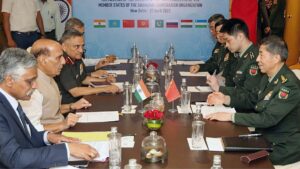US EXPRESSES SUPPORT FOR INDIA AGAINST CHINA’S COERCIVE TACTICS AT BORDER

US EXPRESSES SUPPORT FOR INDIA AGAINST CHINA’S COERCIVE TACTICS AT BORDER
Washington Terming China as the most consequential strategic contender to the United States for the coming decades, the US public defence strategy( NDS) has committed to heightening America’s major defence cooperation with India to enhance its capability to discourage China both at land and ocean
Washington Terming China as the most consequential strategic contender to the United States for the coming decades, the US public defence strategy( NDS) has committed to heightening America’s major defence cooperation with India to enhance its capability to discourage China both at land and ocean. It has also said that the US will support abettors and mates against acute forms of “ slate zone compulsion ” by China, including at the disputed border with India.
Secretary of Defense Lloyd J Austin released the NDS on Thursday, days after the Joe Biden administration released its public security strategy which declared that its top precedence was outcompeting China and constraining Russia.
In his introductory note to the strategy, Austin said that China remained the US’s “ utmost consequential strategic contender ” for the coming decades. “ I’ve reached this conclusion grounded on the PRC’s decreasingly coercive conduct to reshape the Indo- Pacific region and the transnational system to fit its authoritarian preferences, alongside a keen mindfulness of the PRC’s easily stated intentions and the rapid-fire modernization and expansion of its service. ”
The NDS, Austin noted, directed the Department of Defense to “ act urgently ” to “ sustain and strengthen ” American deterrence against China, which has been linked as the pacing challenge for the department. The strategy also speaks of working to support “ robust deterrence ” against Russia, while “ mitigating and guarding against pitfalls from North Korea, Iran, violent revolutionist associations and trans- boundary challenges similar as climate change ”.
In a section on the security terrain, the strategy says that China is seeking to undermine US alliances and hookups in the region and influence its growing capabilities to “ force neighbours and hang their interests ”. It terms China’s “ decreasingly instigative rhetoric and coercive exertion ” towards Taiwan as destabilising, and risking misapprehension. “ This is a part of a broader pattern of destabilizing and coercive PRC gestethat stretches across the East China Sea, South China Sea and the Line of factual Control ”, the last being a nod to China’s aggression at the border with India.
The NDS also outlines China’s growing military capabilities, admitting that Beijing has modernised and expanded “ nearly every aspect ” of the People’s Liberation Army, “ with an end to neutralizeU.S. military advantages ”. The PLA is also fleetly advancing and integrating its “ space, counterspace, cyber, electronic and instructional warfare capabilities ”. The US strategy notes that PLA is also expanding its global footmark, establishing a “ more robust overseas and grounding structure ”, while accelerating the modernisation and expansion of its nuclear capabilities.
The US, NDS says, will decreasingly face the challenge of “ inhibiting two major powers with ultramodern and different nuclear capabilities ”, China and Russia, creating “ new stresses on strategic stability ”.
On the Indo Pacific, NDS says that Pentagon will “ support and make out a flexible security armature ” to sustain a “ free and open indigenous order and discourage attempts to resolve controversies by force ”. The strategy says the US will modernise its alliance with Japan and strengthen “ combined capabilities by aligning strategic planning and precedences in a more intertwined manner ”; Washington will consolidate its alliance with Australia with “ investments in posture, interoperability and expansion of multinational cooperation ” and foster advanced tech cooperation through AUKUS and Quad.
It’s in this section that the strategy speaks of India. “ The Department will advance our Major Defense Partnership with India to enhance its capability to discourage PRC aggression and insure free and open access to the Indian Ocean region. ” It also goes on to commit support for Taiwan’s “ asymmetric tone- defense ”, work with South Korea to ameliorate its defence capability, promote the part of ASEAN in addressing indigenous security challenges, and “ insure power protuberance in a contested terrain ”.
The strategy also says that the US will work with abettors and mates to address “ acute forms of argentine zone compulsion ” by China’s juggernauts to establish control over the “ East China Sea, Taiwan Strait, South China Sea, and disputed land borders similar as with India ”.
NDS has listed four top precedences for Pentagon – defending the motherland; inhibiting strategic attacks against the US, its abettors and mates; inhibiting aggression and preparing to prevail in conflict; and icing US’s military advantage by erecting a flexible common force and defence ecosystem. The strategy plans to achieve these precedences by fastening on integrated deterrence, juggernauts and conduct, with integrated deterrence containing working seamlessly across “ warfighting disciplines, theaters, diapason of conflict, all instruments of US public power, and our networks of Abettors and hookups ”.





